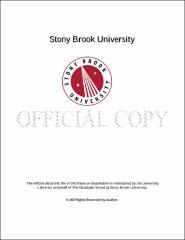| dc.identifier.uri | http://hdl.handle.net/11401/76815 | |
| dc.description.sponsorship | This work is sponsored by the Stony Brook University Graduate School in compliance with the requirements for completion of degree. | en_US |
| dc.format | Monograph | |
| dc.format.medium | Electronic Resource | en_US |
| dc.language.iso | en_US | |
| dc.publisher | The Graduate School, Stony Brook University: Stony Brook, NY. | |
| dc.type | Dissertation | |
| dcterms.abstract | Focusing on the years immediately following World War I and concluding with the present, this dissertation examines the connections across a range of artists and periods in German art in terms of what I will call radical traditionalism. This analysis involves the work of George Grosz, Otto Dix, Gerhard Richter, and Neo Rauch, all artists who, despite their differences in styles and contexts, can be grouped together in their commitment to bringing forth a heterogeneous vision of figurative painting that looks beyond the limitations that have tended to frame the discussion of artistic modernism, namely, the opposition between abstraction and representation. These artists have in common not only a desire to engage with their world through figuration, but also through the adoption and adaptation of traditional models of painting that had been marginalized in mainstream modernism. Nonetheless, their turn towards tradition is anything but conservative or reactionary, as such turns in the twentieth century typically have been conceived, particularly in the long shadows of fascist and socialist realisms; neither does it represent the traditionalism that was a favored tactic of postmodern artists. Examining the work of these artists within a critical framework that draws upon Bertolt Brecht’s conception of dialectical realism, Walter Benjamin’s theory of allegory, Theodor Adorno’s discussion of natural history, and Kaja Silverman’s theory of analogy, among others, this dissertation argues that these artists produce a critical, dialectical form of realism expansive in its outlook and form, borrowing from tradition to put it into productive dialogue with their own historical moments and in ways that expand the concept and practice of realism, pointing to its continued significance in the present and future. | |
| dcterms.abstract | Focusing on the years immediately following World War I and concluding with the present, this dissertation examines the connections across a range of artists and periods in German art in terms of what I will call radical traditionalism. This analysis involves the work of George Grosz, Otto Dix, Gerhard Richter, and Neo Rauch, all artists who, despite their differences in styles and contexts, can be grouped together in their commitment to bringing forth a heterogeneous vision of figurative painting that looks beyond the limitations that have tended to frame the discussion of artistic modernism, namely, the opposition between abstraction and representation. These artists have in common not only a desire to engage with their world through figuration, but also through the adoption and adaptation of traditional models of painting that had been marginalized in mainstream modernism. Nonetheless, their turn towards tradition is anything but conservative or reactionary, as such turns in the twentieth century typically have been conceived, particularly in the long shadows of fascist and socialist realisms; neither does it represent the traditionalism that was a favored tactic of postmodern artists. Examining the work of these artists within a critical framework that draws upon Bertolt Brecht’s conception of dialectical realism, Walter Benjamin’s theory of allegory, Theodor Adorno’s discussion of natural history, and Kaja Silverman’s theory of analogy, among others, this dissertation argues that these artists produce a critical, dialectical form of realism expansive in its outlook and form, borrowing from tradition to put it into productive dialogue with their own historical moments and in ways that expand the concept and practice of realism, pointing to its continued significance in the present and future. | |
| dcterms.available | 2017-09-20T16:51:14Z | |
| dcterms.contributor | Uroskie, Andrew V | en_US |
| dcterms.contributor | Patterson, Zabet | en_US |
| dcterms.contributor | Mather, David | en_US |
| dcterms.contributor | McCloskey, Barbara. | en_US |
| dcterms.creator | English, Travis William | |
| dcterms.dateAccepted | 2017-09-20T16:51:14Z | |
| dcterms.dateSubmitted | 2017-09-20T16:51:14Z | |
| dcterms.description | Department of Art History and Criticism. | en_US |
| dcterms.extent | 206 pg. | en_US |
| dcterms.format | Monograph | |
| dcterms.format | Application/PDF | en_US |
| dcterms.identifier | http://hdl.handle.net/11401/76815 | |
| dcterms.issued | 2015-12-01 | |
| dcterms.language | en_US | |
| dcterms.provenance | Made available in DSpace on 2017-09-20T16:51:14Z (GMT). No. of bitstreams: 1
English_grad.sunysb_0771E_12302.pdf: 1155437 bytes, checksum: df5f09aee8f1cf9e604ce31f33bea02a (MD5)
Previous issue date: 1 | en |
| dcterms.publisher | The Graduate School, Stony Brook University: Stony Brook, NY. | |
| dcterms.subject | Art history | |
| dcterms.subject | Figuration, Germany, Modernism, Painting, Realism, Traditionalism | |
| dcterms.title | Painting Against the Grain of History: Radical Traditionalism in Twentieth Century German Art | |
| dcterms.type | Dissertation | |

